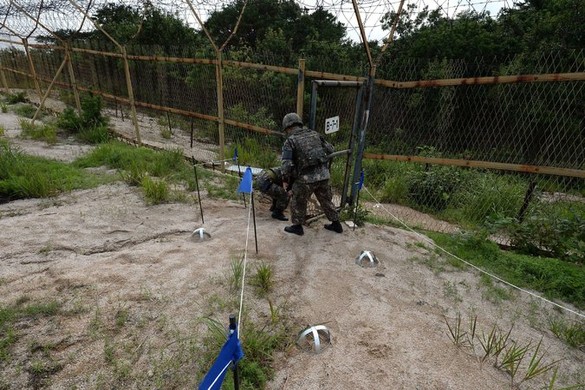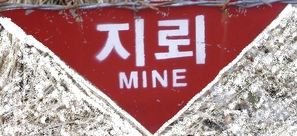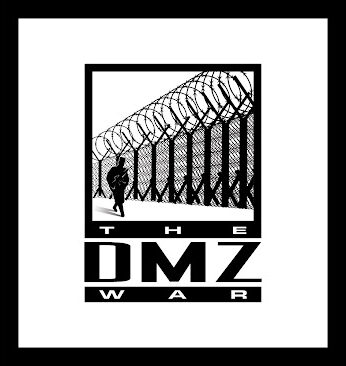Land Mine Korea: Aug. 2015 Wounding of RoKs & US Poly Debate Over Mines
Click on the Image
See Link Below for Interesting Photos on the Story


Many readers of this site will recognize the tactic: North Korean infiltrators plant a booby trap around a fence gate used by South Korean forces inside the DMZ, about 1,440 feet south of the MDL. One ROK NCO lost his legs in the initial blast, a second sergeant lost his leg trying to assist the first victim.
South Korean officials claim this is the first such attack using box mines since 1967, reports the NY Times (click on the picture above for the story), so the ROK soldiers may have been less than vigilant about checking their patch for mines (a process many of our readers will recall).
South Korea reports its investigation [assisted by its US and other allies on the UNC] reveals the mines were placed recently and not deposited there by natural forces such as soil drift or flooding. [Remarkably, the Times reports claims by both Korea governments that infiltration of the DMZ stopped “in the 1970s,” a falsehood even a quick search of the Times own clippings would likely reveal.]
The South Korean military promised “severe retaliation” for the attack, which so far appears to be the resumption of South Korean propaganda broadcasts into the DMZ (another memory for many readers of this site); see the CNN report here. The South Korean loudspeakers were shut down years ago, and North Korea has threatened to attack them if they start up again.
To learn more about mines in the Korean DMZ and their status in the Obama Administration’s effort to bar use of mines by the US military, see our report here.
The Debate over American Land Mines in South Korea

Pentagon Statement on Land Mines (7/1/14)
“It is important to note that the U.S. maintains no minefields anywhere in the world. Since 1991, we are aware of only one confirmed operational employment of APL by U.S. military forces, a single munition in Afghanistan in 2002. This decision on anti-personnel landmines, given our current stockpiles, protects current capabilities while we work towards a reliable and effective substitute. Landmines, used responsibly, are a valuable tool in the arsenal of the United States which can save US and allied lives. As a matter of policy, we do not discuss security arrangements between allies and partner nations. ”
CDR Amy Derrick-Frost, USN
OASD PA Press Officer
“U.S. says will no longer make, buy anti-personnel landmines” (6/27/14)
WASHINGTON (Reuters) – The United States said on Friday it would no longer make or buy anti-personnel landmines and that it would strive to eventually join the global treaty banning the weapons, but it stopped short of agreeing to destroy its stockpile of 3 million mines. More
House Response to President O’s New Land Mines Policy (6/27/14)
Jun 27 2014
McKeon Statement on President Obama’s Land Mine Announcement
Washington, D.C. – House Armed Services Committee Chairman Howard P. “Buck” McKeon (R-CA) made the following statement about President Obama’a announcement today on land mines:
“Once again, the President makes an end-run around Congress and demonstrates his willingness to place politics above the advice of our military leaders. His announcement today is perfect for a feel good press release but bad for the security of our men and women in uniform. It is truly an expensive solution in search of a nonexistent problem. Irresponsible land mine use by other countries has come at a high humanitarian price, but America isn’t part of that problem. Indeed, we do more than any other country to clean up these irresponsible weapons. General Dempsey has long declared the responsible land mines we use are an ‘important tool in the arsenal of the Armed Forces of the United States.’ The President owes our military an explanation for ignoring their advice and putting them at risk- all for a Friday morning press release.”
White House Statement on Land Mines (6/27/14) Statement by NSC Spokesperson Caitlin Hayden on U.S. Anti-Personnel Landmine Policy
Today at a review conference in Maputo, Mozambique, the United States took the step of declaring it will not produce or otherwise acquire any anti-personnel landmines (APL) in the future, including to replace existing stockpiles as they expire. Our delegation in Maputo made clear that we are diligently pursuing solutions that would be compliant with and ultimately allow the United States to accede to the Ottawa Convention—the treaty banning the use, stockpiling, production, and transfer of APL. They also noted we are conducting a high fidelity modeling and simulation effort to ascertain how to mitigate the risks associated with the loss of APL. Other aspects of our landmine policy remain under consideration and we will share outcomes from that process as we are in a position to do so.
The United States shares the humanitarian goals of the Ottawa Convention, and is the world’s single largest financial supporter of humanitarian mine action, providing more than $2.3 billion in aid since 1993 in more than 90 countries for conventional weapons destruction programs. We will continue to support this important work, and remain committed to a continuing partnership with Ottawa States Parties and non-governmental organizations in addressing the humanitarian impact of APL.
White House Fact Sheet on Land Mines (6/27/14)
Fact Sheet: Changes to U.S. Anti-Personnel Landmine Policy
The United States announced today that it will not produce or otherwise acquire any anti-personnel landmines (APL) in the future, including to replace expiring stockpiles. The announcement, delivered at the Third Review Conference of the Ottawa Convention in Maputo, Mozambique, underscores the U.S. commitment to the spirit and humanitarian aims of the Ottawa Convention, the treaty that prohibits the use, stockpiling, production, and transfer of APL. The U.S. delegation in Maputo further announced that the United States is diligently pursuing solutions that would be compliant with and that would ultimately allow the United States to accede to the Ottawa Convention. We are also conducting a high fidelity modeling and simulation effort to ascertain how to mitigate the risks associated with the loss of APL. Other aspects of U.S. landmine policy remain under consideration, and we will share outcomes from this process as we are able to do so.
This announcement marks another important step in our landmine policy. It follows previous steps to end the use of all non-detectable mines and all persistent mines, which can remain active for years after the end of a conflict.
The United States is also the world’s single largest financial supporter of humanitarian mine action, which includes not only clearance of landmines, but also medical rehabilitation and vocational training for those injured by landmines and other explosive remnants of war. Since the United States Humanitarian Mine Action Program was established in 1993, the United States has provided over $2.3 billion in aid in over 90 countries for conventional weapons destruction programs. Through this assistance, the United States has:
Helped 15 countries to become free from the humanitarian impact of landmines;
Provided emergency assistance to support the removal or mitigation of conventional weapons including landmines and other unexploded ordnance in more than 18 countries; and
Provided assistive devices and other rehabilitation services to over 250,000 people in 35 countries through the U.S. Agency for International Development-managed Leahy War Victims Fund.
These vital U.S. assistance efforts help post-conflict countries consolidate peace and set the stage for reconstruction and development. Clearance efforts and victim assistance programs return land and infrastructure to productive use and assist in the rehabilitation and reintegration into society of survivors of mine and explosive remnants of war incidents.
Further information on U.S. humanitarian demining and conventional weapons destruction programs can be found in the State Department’s annual To Walk the Earth in Safety report.
Excellent Summary of Korean Land Mine Debate
“(O)ne of the biggest potential sources of opposition to the treaty may be some of President Obama’s top military advisers who have defended the use of landmines as essential to fulfilling U.S. national defense needs.
Chairman of the Joint Chiefs Martin Dempsey testified before Congress in March of this year that he had rendered his military advice that landmines are “an important tool in the arsenal of the armed forces of the United States.” Dempsey emphasized that U.S. landmines can be set for specific times and are designed to self-destruct, thus posing less of a danger to civilians during and after conflicts.
Less than a month later, General Curtis Scaparrotti, the current commander U.S. commander in Korea, testified before Congress that landmines “are a critical element in the defense of the Republic of Korea and our interest there. And they’re a critical element of our contingency plans, as well.”
A recent 30-page Joint Staff assessment detailed the dangers of a landmine ban with special concern for U.S. defense of South Korea, according to sources briefed on the report. However, the assessment remains classified.
The Ottawa Treaty aims to eliminate anti-personnel landmines, and has contributed to a dramatic decline in related casualties. Between 1999 and 2011, the number of reported new landmine casualties dropped by more than half, from 8,807 to 4,286. Most casualties occur in just a few countries – Afghanistan, Colombia, and Cambodia had the worst records during that twelve year period:” Real Clear Defense (6/20/14)
President Obama to Remove Defensive Mine Shield from GIs in Korean (6/19/14)
President Obama, according to the Wall Street Journal, “plans next week to sign the international treaty banning land mines, an act of arms-control theater that will weaken longstanding U.S. defenses against the erratic and nuclear-armed regime of North Korea.”
We hope this report is not true; if it is, it represents another failure of the White House to understand and stand up for US service members, as well as a fundamental misapprehension about how best to protect civilians from the horrors of war on the Korean Peninsula (the decision would, however, match North Korea’s position on the matter, according to its official media).
The “Ottawa Treaty” bans anti-personnel land mines because they can wound and kill civilians, even after a conflict is over. But Presidents Clinton and Bush, who took action against the general threat of land mines, refused to sign the treaty because it means stripping a key defensive shield from our troops and allies in Korea. The need for that shield is clear, even in conditions short of total war. See the full story at our sister site Korean News.
New US “Smart Mines” Meet Military Objectives & Safeguard Civilians: Study
“The major reasons for seeking alternatives to current antipersonnel landmines (APL) are humanitarian concerns, compliance with the Ottawa Convention, and enhanced military effectiveness. Indeed, this study would not have been empanelled were it not for the Ottawa Convention. The current inventory of self-destructing and self-deactivating U.S. APL is militarily advantageous and safe. They achieve desired military objectives without endangering U.S. warfighters or noncombatants more than other weapons of war, but they are not compliant with the Ottawa Convention. However, humanitarian concerns and Ottawa compliance are not always synonymous. In fact, some of the apparently Ottawa-compliant alternatives examined by the committee may be less humane than present U.S. self-destructing and self-deactivating landmines.” National Academy of Sciences Study
House Moves to Block President from Removing Korean Land Mines (6/20/14)
The Chairman of the House Armed Services Committee issued this statement today on President Obama’s reported decision to agree to the Ottawa Convention, which would strip GI’s of their defensive land mines in Korea. See the story at our sister site.
Distraught Villager Restrained Trying to Eat Heart from Dead NK Soldier Seven Members of this Man’s Family Killed by NK Team
